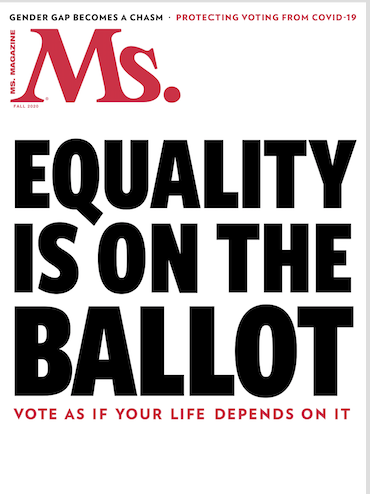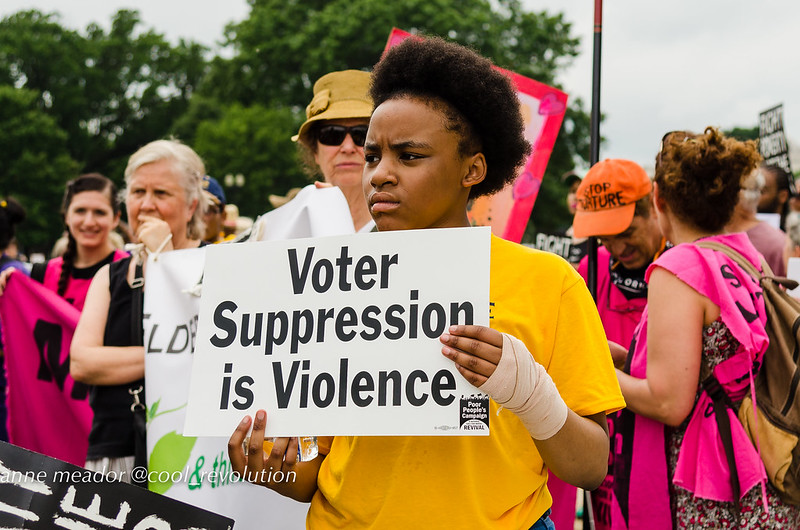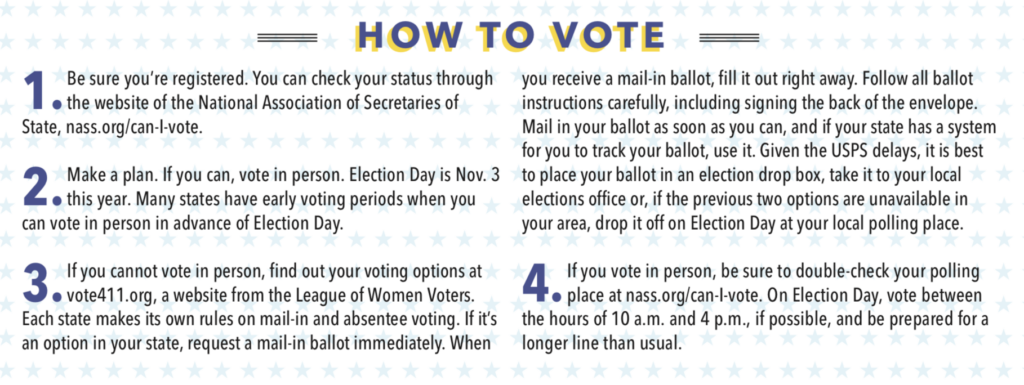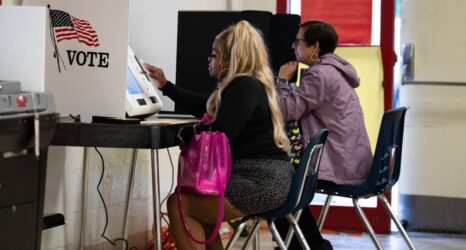In a normal year, Labor Day is the unofficial start of the presidential campaign season. In a normal year, kids are back in school. Voters are being bombarded with political ads on TV and in their social media feeds, while in battleground states, candidates hold rallies and town hall meetings.
But 2020, needless to say, is not a normal year.
From now until Election Day, we will examine how the ongoing battle over voting rights will have an impact on the country’s ability to hold fair elections during a pandemic, as well as on the difference women will make as voters and candidates.

More than any other previous election: Equality is on the ballot.
This article originally appeared in the Fall 2020 issue of Ms.
Become a member today to read more reporting like this in print and through our app.
A Country Already Under Assault From Voter Suppression
Before August 1920, a white American woman who tried to vote in a presidential election risked getting arrested. It took another 45 years for the threat of death to diminish for Black Americans attempting to vote in the South.
But a hundred years after passage of the 19th Amendment and 55 years after the Voting Rights Act of 1965, there’s another ominous threat to the voting electorate, one that’s literally wafting through the air. The COVID-19 pandemic has resulted in a potential barrier to voting that not even the most vigilant of voting rights advocates could have prepared for.
This scenario is unfolding just as the U.S. is being forced to confront a raft of unacknowledged wounds fueled by race, gender and economic inequity. They have sparked urgent conversations about the underpinnings of American democracy and what may be at stake in the elections of 2020. As protesters flood the streets to denounce systemic racism and police brutality and a range of socioeconomic injustices, to some observers the remedy lies in one seemingly simple location: the ballot box.
Yet at a time when the voice of the people needs to be most full-throated, American democracy has never been more vulnerable. That’s in part because the COVID-19 crisis has presented a fresh crop of voter suppression threats and hurdles that could further erode the concept of “one [wo]man, one vote” for decades to come.
“I don’t want to understate voter suppression, because voter suppression is real,” says Marian Lewin, vice president of the board of directors for the League of Women Voters of North Carolina, a state with a long and storied history of voting-access barriers and the resultant legal challenges. “The people in power want to stay in power, and the best way to stay in power is that you choose who your voter is.”
Voter suppression and intimidation strategies—which include onerous voter ID rules, the relocation and closing of polling sites, and the restriction of voting hours and elimination of early voting days—have had a significant impact on election outcomes throughout the years. Because individual states are allowed to develop their own rules and guidelines around where, when and how to vote, there’s seemingly endless opportunity for voter suppression.

One key suppression strategy is the purging of names from voter registration lists for reasons ranging from expired drivers’ licenses to changes in marital status. This issue became a rallying cry for former Georgia gubernatorial candidate Stacey Abrams, who invoked it in 2018 following her narrow election defeat. Her challenger, Brian Kemp, then secretary of state, oversaw the elections, which were also criticized for polling location closures and long lines to vote.
An analysis of public records in Georgia by American Public Media found that prior to the election 107,000 names had been dropped from the voter rolls for lack of participation in at least one election. (Kemp won by a margin of fewer than 55,000 votes.)
In North Carolina, where Lewin lives, a 2019 purge of voter registration rolls, part of a series of efforts to purge voter rolls before and since, dropped more than half a million names; there are (and have been) numerous lawsuits seeking to remove even more.
“There are so many lawsuits, it’s just hard to keep up with,” Lewin says.
In April 2020, for instance, the conservative group Judicial Watch sued the state of North Carolina and the Mecklenburg County elections director, as well as Guilford County and its elections director and chair, alleging that tens of thousands of names on the voter rolls still needed to be eliminated. A decision on the lawsuit is pending.
In August, a federal judge ruled in a case brought by Lewin’s organization along with Democracy North Carolina and Southern Coalition for Social Justice, that the North Carolina State Board of Elections had to allow voters to correct mistakes on absentee ballots—a process known as “curing”—instead of automatically tossing them out.
When such cases reach the Supreme Court, the outcome usually isn’t as favorable. Over the past decade, voter advocacy efforts have been hobbled by regressive Supreme Court decisions. The major blow came in the form of the June 2013 Shelby County v. Holder decision, which ruled that Section 5 of the Voting Rights Act was unconstitutional. Section 5 required jurisdictions with a history of discrimination to submit any proposed changes in voting procedures to the U.S. Department of Justice or a federal district court in D.C. before they could be enacted. It was specifically designed to prevent discrimination against minority voters.
“Without Section 5 protections, we have seen the floodgates for voter suppression open up in those communities [with a history of discrimination] across the country,” says Kristen Clarke, president and executive director of the Lawyers’ Committee for Civil Rights Under Law. “Because they now no longer need to take that step of getting review for what they’re doing, and they’ve exploited the moment. From Texas to North Carolina, Georgia and many other places, we have seen intense and relentless efforts to make it harder for people of color to vote.”
By mid-2020, the Supreme Court had handed down four more blows to voting rights, while turning a blind eye to the increased barriers to voting caused by the COVID-19 crisis.
In April, just before the Wisconsin primary election, the Court’s five conservative justices reversed a federal judge’s order to expand the period for accepting absentee ballots. Voters who feared standing in long lines to vote had submitted what was characterized by a federal judge as an “avalanche of absentee ballots,” which local election officials said they weren’t able to process.
As a result of the Court’s decision, the ballots that were deemed to have arrived too late were thrown out. The ruling has huge ramifications for November: The Trump administration’s recent “cost-cutting” measures at the U.S. Postal Service have heightened concerns about whether absentee ballots will be delivered properly and on time.

In June, the Texas Democratic Party lost its case before the Court, in which it was seeking to remove barriers written into Texas law on absentee voting for people younger than 65. “Some officials are failing to acknowledge the impact that the pandemic is having on democracy. And we see that in places like Texas and Tennessee, where officials have taken a stance that fear of contracting COVID is not a basis to access an absentee ballot,” Clarke notes.
In July, the Court blocked plans for curbside collection of absentee ballots, known as “curbside voting,” and expanded use of absentee ballots in three Alabama counties. The ruling also preserved a requirement that absentee voters provide an affidavit signed by a notary public or two adult witnesses along with their ballot. Finally, in a Florida case, the Court preserved an order by the 11th U.S. Circuit Court of Appeals barring thousands of formerly incarcerated people from voting in an August primary (and possibly in November), in spite of the fact that two years ago Floridians voted overwhelmingly to enfranchise this population.
Taken as a whole, the recent Supreme Court decisions diminish the voting rights of poor people, people of color and those who fear contracting COVID-19. Clarke, for one, believes these high court rulings are surprisingly tone-deaf.
“I’m deeply concerned that this Court, while operating remotely in a pandemic, is not willing to extend those privileges to people who are trying to vote right now,” she says. “And we literally have people in communities who have been put in a position of choosing between their health and exercising the right to vote this season.”
The decisions send an ominous message to people of color, says Myrna Pérez, director of the Voting Rights and Elections program for the Brennan Center for Justice in New York City. “We can’t underestimate what it says to people that the Supreme Court is not going to step in and protect the right to vote,” Pérez says.
Keep reading:





